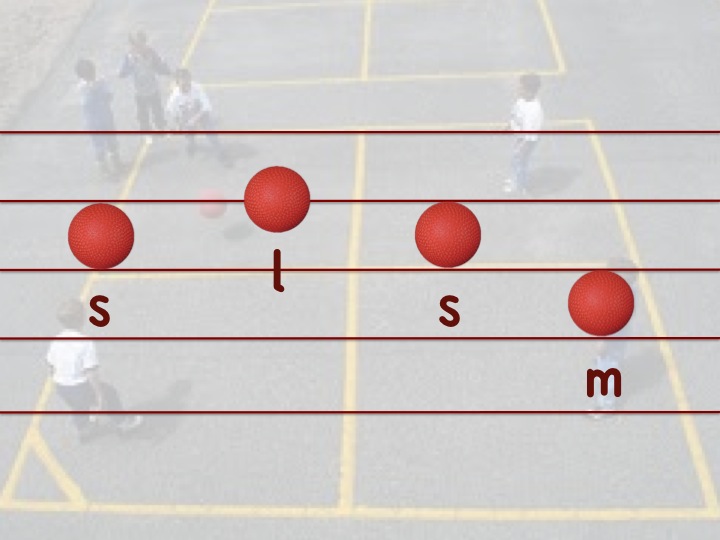My second graders are prepping do but this week, with just getting back from Winter Break, we practiced la in addition to doing some aural and kinesthetic prep work for do.
I wrote a post about Bounce High a while ago, but I never included the PowerPoint (note: that post has more specifics about the game!!!). The song "Plainsies, Clapsies" works well in the same lesson with "Bounce High, Bounce Low"- they both practice la and they both use bouncing balls so it makes for a nice transition.
Here's Bounce High, Bounce Low:
For the game, click here.
Now, to "walk" through the PowerPoint.
There's a lyric slide from which the students sing the song:
There's an iconic beat slide, which can be used for the rhythmic preparation of ta & ti-ti. With my kiddos, we pat the beat with "spider fingers" while singing:
An iconic rhythm slide for ta & ti-ti preparation. With my kiddos we clap the rhythm (two finger clap, makes it more musical!):
There are two slides to practice ta & ti-ti reading, one with stick notation without note heads:
And a stick notation with note-heads:
Here are the first melodic preparation slides that they read. When we are preparing we will read these slides with body signs: hands on shoulders for mi, hands on head for so and hands in the air, just about the head, for la:
When we are in late preparation of la, we read these slides. We are wanting to hone in on that there is a new note, that the new note is higher than both so and mi and that it's just a "little" above so:
One these late preparation slides we sing the solfa we know and hum the unknown note. I have the kiddos use the so and mi hand signs and "shrug" on the unknown note:
We also read it on the staff, this is a good visual prep for the relationship of la to so- they start to see that la is not in the same "family as so & mi. By this, we talk about so-mi being in the same family in that if so is on a space then mi is in a space and if so is on a line then mi is also on a line. This visual prep gets them thinking about how this note is different). I have it notated in the PowerPoint in two different keys so they can see the "space-line" relationship that I was just talking about:
And here are the presentation slides, they are essentially the same as the preparation slides but now la is labeled:
Additionally, the practice slides use "real" notes from which the students can read the song. I do NOT teach absolute pitch to my 1st and 2nd graders, we'll get into that in 3rd grade.:
Now, the "Plainsies, Clapsies" PowerPoint is set up identically so that it's consistent vocabulary and presentation for the students. ** If we are working on la, we might or might not use the rhythm slides. . . it depends on the needs of the class.
Here are examples (snippets) of the "Plainsies, Clapsies" PowerPoint:
Lyric slide:
Beat slide:
Rhythm prep slide:
Rhythm practice slides:
Prep slides for la:
Practice slides for la:
These are available in one PDF on my Teacher Pay Teachers store. I'm going to be starting a monthly give away to all the followers on my Teachers Pay Teachers store, so please follow me there. I'm up to 100 followers on this blog, if you're not already following me, please do! I'd love the company! :)
















































I love your work and would happily make my donation to you in Teachers pay Teachers, but since your slides and PDFs aren't setup for C based pitches, Mr Everybody, or Color-Based-Notes through Boomwhackers, a lot of teachers will have trouble adapting your awesome slides and designs in their curriculum. Just food for thought when you continue to design.
ReplyDeleteThanks Tom, great feedback, I appreciate it!
Delete